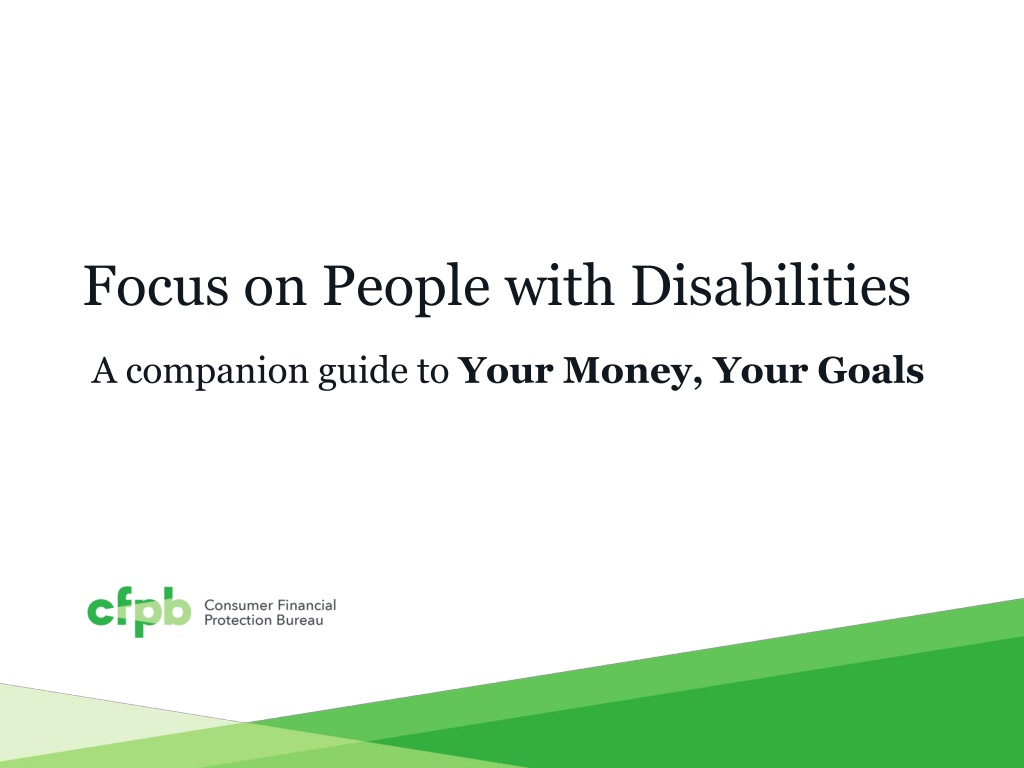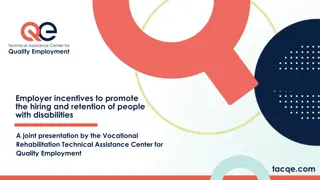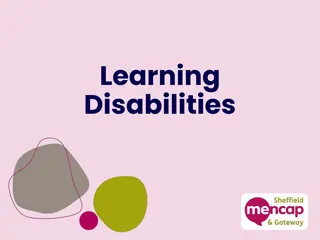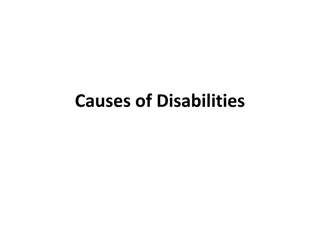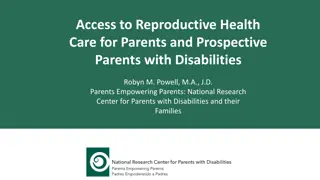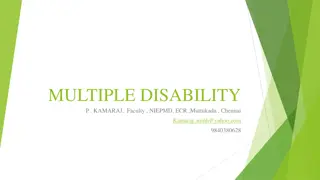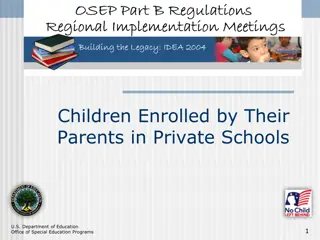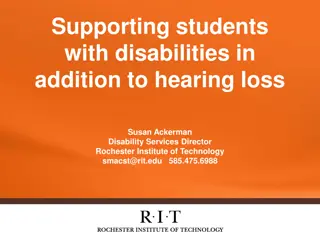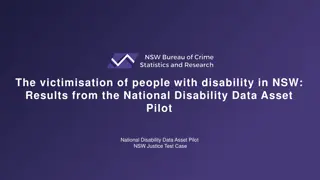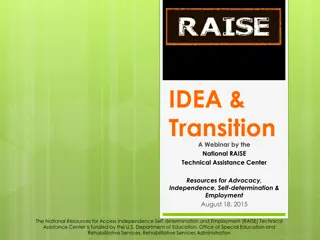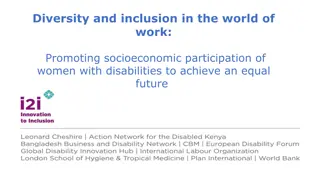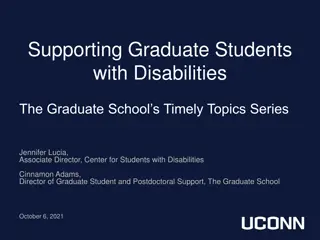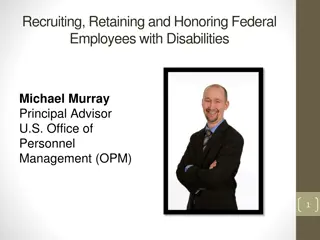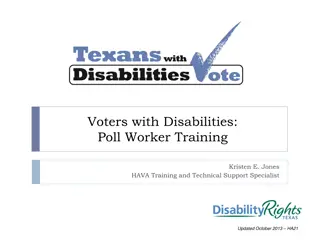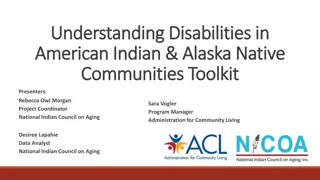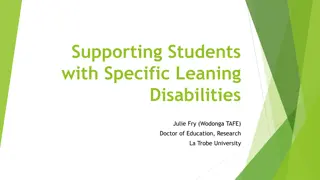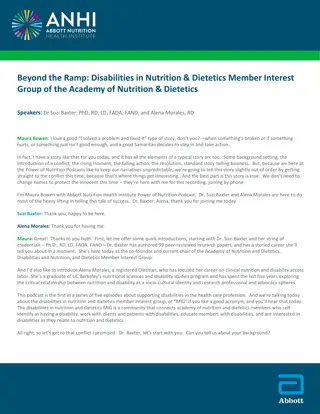Focus on People with Disabilities
Millions of Americans with disabilities face unique financial challenges, with higher rates of unemployment and poverty. This guide, created by the Consumer Financial Protection Bureau, aims to help individuals with disabilities make informed financial decisions and reach their goals. By understanding their financial needs and barriers, we can work towards a more inclusive and empowered community.
Download Presentation

Please find below an Image/Link to download the presentation.
The content on the website is provided AS IS for your information and personal use only. It may not be sold, licensed, or shared on other websites without obtaining consent from the author.If you encounter any issues during the download, it is possible that the publisher has removed the file from their server.
You are allowed to download the files provided on this website for personal or commercial use, subject to the condition that they are used lawfully. All files are the property of their respective owners.
The content on the website is provided AS IS for your information and personal use only. It may not be sold, licensed, or shared on other websites without obtaining consent from the author.
E N D
Presentation Transcript
Focus on People with Disabilities A companion guide to Your Money, Your Goals
Disclaimer The Consumer Financial Protection Bureau (CFPB) created the Your Money, Your Goals toolkit for consumers, as well as the training materials presented today. These materials are being presented to you by a local organization. The organizations or individuals presenting these materials are not agents or employees of the CFPB, and their views do not represent the views of the CFPB. The CFPB is not responsible for the advice or actions of these individuals or entities. The CFPB appreciates the opportunity to work with the organizations that are presenting these materials. This document includes links or references to third-party resources. The inclusion of links or references to third-party sites does not necessarily reflect the CFPB s endorsement of the third-party, the views expressed on the third-party site, or products or services offered on the third-party site. The CFPB has not vetted these third-parties, their content, or any products or services they may offer. There may be other possible entities or resources that are not listed that may also serve your needs. 2
Training objectives Understand the content of Focus on People with Disabilities and how it complements the Your Money, Your Goals toolkit. Know how to use the information and tools to help people with disabilities take steps to reach their financial goals. Increased awareness of the Consumer Financial Protection Bureau s financial education resources. 3
The CFPB An introduction to the Consumer Financial Protection Bureau 4
The CFPBs mission and vision MISSION To regulate the offering and provision of consumer financial products or services under the Federal consumer financial laws and to educate and empower consumers to make better informed financial decisions. VISION Free, innovative, competitive, and transparent consumer finance markets where the rights of all parties are protected by the rule of law and where consumers are free to choose the products and services that best fit their individual needs. 5
People with disabilities and financial decision making Millions of Americans with disabilities face unique financial needs or barriers. 8% unemployment rate for adults with disabilities, more than double the national average. (Bureau of Labor Statistics, 2018) 27% poverty rate for people with disabilities ages 18-64, compared to 12% poverty rate for adults without disabilities. (The Disability Statistics Compendium, 2017) May not have had substantial prior experience in making financial decisions that affect their lives. These challenges and also opportunities make financial empowerment for the disability community especially important. 6
Your Money, Your Goals landing page To subscribe for email updates on new consumer resources and guides visit: www.consumerfinance. gov/your-money-your- goals 7
Your Money, Your Goals An orientation to the toolkit 8
Your Money, Your Goals: Resources Toolkit Online resources Booklets Behind on bills? Debt getting in your way? Want credit to work for you? Companion guides Native Communities Reentry People with Disabilities 9
Focus on People with Disabilities Exploring the guide 10
Focus on People with Disabilities contents (1 of 2) Introduction People with disabilities and financial decision making Using the Your Money, Your Goals toolkit and guide How to begin Tool: Starting the money conversation Modules: Your Money, Your Goals for People with Disabilities Additional resources 11
Focus on People with Disabilities contents (2 of 2) Module 1: Setting Goals Tool: Paying for assistive devices Module 2: Saving Tool: Setting up an ABLE Account Module 3: Tracking Income and Benefits Tool: SSI estimator Module 4: Paying Bills Module 5: Getting through the Month Tool: Monthly budget Module 6: Dealing with Debt Module 7: Understanding Credit Reports and Scores Module 8: Choosing Financial Products and Services Module 9: Protecting your Money Tool: Identifying financial abuse and exploitation Additional resources 12
How to begin Resources for having the money conversation Introductory information about Your Money, Your Goals Information on financial empowerment Tips and scripts for starting the money conversation Focus on People with Disabilities, Tool: Starting the money conversation 13
Tool: Starting the money conversation Help identify financial challenges. Help zero in on the information and tools that will be most useful to them. Help you determine where to start the financial empowerment discussion. 14
Tool: Starting the money conversation, response key Use to analyze responses Determine where to start the financial empowerment discussion 15
Modules: Your Money, Your Goals for People with Disabilities (Modules 1-9) 16
Navigating the modules Tool Handout
Module 1: Setting Goals Setting goals is an essential part of the foundation for achieving self- sufficiency. Goals can also help people plan how to use their money. Examples of large goals: Paying for assistive devices Buying a car Paying for adaptations to vehicles Paying medical expenses Renovating your home Paying for training or post-secondary education Specific, Measurable, Able-to-be-Reached, Relevant and Time bound (SMART) Goals 19
Module 2: Saving Saving is about setting aside resources today so they can be used in the future. It s about balancing your resources to take care of your family and community. Discuss the importance of: Finding a safe and secure place for savings How covering emergency needs with savings can save money How to build up savings Savings, benefits, and asset limits 21
Building savings while receiving public benefits For many people with disabilities who receive public benefits, saving may not seem to be an optionthat s available to them. This is because some benefit programs may have asset limits. There are savings options for individuals with disabilities that do not impact the asset limits associated with SSI, Medicaid, or other benefits.* Achieving a Better Life Experience (ABLE) Accounts Plans to Achieve Self-Support (PASS) Special needs trusts and pooled trusts * These options are complicated and you may need more information after using this introductory summary. 22
Achieving a Better Life Experience (ABLE Act) Account Important new resource for people with disabilities Savings in an ABLE Account does not affect eligibility for: Supplemental Security Income (SSI)* Medicaid and other federal means-tested benefits* ABLE Account programs are established and maintained by individual states. An eligible person can open an account: In their own state, if a program exists In any state program that accepts out of state residents. * Benefits issues are complicated and individuals should consult a specialist familiar with their situation before making decisions that could affect benefits. 23
Tool: Setting up an ABLE Account 1. Ask these questions to determine if an ABLE Account is an option for you. Do you meet the eligibility requirements? Do your goals match the qualified disability expenses allowed that can be paid from an ABLE Account without incurring taxes? Do you have the minimum contribution required to open an account? Can you to continue to make contributions to the ABLE Account once it s opened? 2. Fill in the worksheet on the next page to compare features of different plans if you determine you would like to open an ABLE Account. 24
Module 3: Tracking Income and Benefits For many people with disabilities, tracking income may mean tracking their benefits payments. Income: Regular income, irregular income, seasonal, one-time occurrences Benefits: Supplemental Security Income (SSI), Social Security Disability Insurance (SSDI), others Visit the Social Security Administration at www.ssa.gov. 26
Using the Income and benefits tracker A first step is tracking income and financial resources. Use this tool to help a person you serve understand the amounts and timing of their financial resources and income. Encourage the person you serve to track their income and financial resources for a day, a week, two weeks, or a month. Itmay be the first time they understand where they get their money and how much they have to work with. 27
Tool: Income and benefits tracker What to do: 1. Gather all of your pay stubs, benefits statements, and records of electronic payments. 2. Enter the amount of income or benefits you receive next to the correct category in the appropriate week of the month.
Using the SSI estimator tool Use this tool to help a person with a disability understand how earnings from work affect their SSI benefit. Go through each point in the tool and work out the math with the person you are serving. First, when a person earns money through a job, they keep the first $85 of their pay without any impact on their SSI. For every dollar they earn after that, SSI drops by 50 cents. Many people think that getting paid at a job could result in stopping their SSI check, but that is not necessarily true. In general, the more a person works, the more they make overall, even when receiving SSI. 29
Handouts with specialized information Workforce Investment Opportunity Act (WIOA) WIOA provides opportunities for people with disabilities because key provisions of the Act strengthen services to youth and adults with disabilities. The role of a representative payee A representative payee is a person or an organization. The Social Security Administration may appoint a payee to receive the Social Security or SSI benefits for anyone who can t manage or direct the management of their benefits. 31
Module 4: Paying Bills Spending Money you use to pay for a wide range of basic needs, your financial obligations, and other things you may want. The way people use their money is often a reflection of their values. When it comes to how the people you serve spend their money, it helps to avoid implying your own personal values and judgement. 32
Module 4 (continued) Depending on circumstances, some people with disabilities may have had limited choices in how to spend their money: This could be because of age. For example, if the person is a minor, a parent or guardian may play a role in financial decision making. In other circumstances, a trustee, family member, or representative payee may play a role in financial decision making. 33
Using the Spending tracker Use this tool to help a person you serve understand how they spend their money. Encourage the person you serve to track their spending for a day, a week, two weeks, or a month. With this information, they may realize where their money goes for the first time. They can then make changes to how they spend their money. The way a person tracks how they spend their money and financial resources does not matter. They should use whatever is most comfortable. 34
Tool: Spending tracker What to do: 1. Get a small container or envelope. Every time you spend money, get a receipt and put it into the case or envelope. 2. Analyze your spending. Go through your receipts and enter the total you spent in each category for each week. 3. Notice trends. Identify any areas you can eliminate or cut back on these will generally be wants.
Module 5:Getting through the Month Module 5:Getting through the Month in the Your Money, Your Goals toolkit brings together the income and spending trackers from Modules 3 and 4 to help create a cash flow budget. The cash flow budget tools let individuals see how much money comes in and where it goes out in spending. The tools also demonstrate how people can make changes in the timing of spending to ensure financial resources and spending are balanced. 36
Exercise: Needs, wants, obligations Needs Wants Obligations 37
Module 5 (continued) Budgeting can help a person with or without disabilities gain and maintain control over their money. Module 5 provides information and tools to help people make plans to get through the month pay for all of their living expenses, bills, financial obligations, and other uses of income or financial resources, including saving. For a person living on a fixed-income, a monthly budget can help them manage their income, benefits, and plan for their expenses. 38
Using the Monthly budget tool Using a monthly budget can be empowering. It can help a person planhow to use their financial resources to support themselves and their family and save for their future. This tool can be used to help manage their income and benefits and plan for expenses. Start by asking about a person s monthly income, benefits, and expenses. Once these questions are answered, the information can be used to create a simple monthly budget. 39
Cash flow What is a cash flow budget? How is it different from a regular budget? What do you think may be the benefit of this approach?
Managing cash flow: Scenario overview Rafael is a single parent with two children. He is often late with his rent and other bills, because he does not have the money when he needs it. After tracking his spending, he developed a cash flow budget with an educator at a parenting class he takes through Cooperative Extension in his community. Using the cash flow, make some recommendations to Rafael so he can make ends meet.
Managing cash flow scenario Week 1 $257.00 Week 2 -$361.00 Week 3 $65.52 Week 4 -$463.22 Beginning Balance for the Week Sources of Cash & Other Financial Resources Income from Job Income from Part-Time Job SNAP Total Sources of Cash & Other Financial Resources Uses of Cash & Other Financial Resources Debt Payments Credit Card Payments Personal loan payments Student Loan Savings Housing (Rent including utilities) Utilities Television Internet Service Phone and Cell Phone Service Household Supplies & Expenses Groceries Eating Out (Meals and Beverage) Transportation Car Payment Fuel Auto Insurance Childcare Misc. Total Uses of Cash & Other Financial Resources Ending Balance for the Week (Sources - Uses) $990.00 $220.00 $990.00 $220.00 $220.00 $412.00 $889.00 $220.00 $849.00 $285.52 $746.78 $90.00 $100.00 $235.00 $0.00 $0.00 $845.00 $0.00 $0.00 $63.48 $22.74 $86.00 $25.00 $80.00 $25.00 $200.00 $25.00 $100.00 $25.00 $80.00 $25.00 $245.00 $60.00 $60.00 $60.00 $175.00 $70.00 $50.00 $783.48 $65.52 $60.00 $70.00 $50.00 $1,250.00 -$361.00 $70.00 $50.00 $748.74 -$463.22 $70.00 $50.00 $385.00 $361.78
Cash flow analysis 1. When does Rafael run out of money? 2. What can he do (or try to do) to better match the timing of his income and his expenses? Develop a prioritized list. 3. How does the SNAP benefit factor into the cash flow? 4. The next month is not included in the example. What will Rafael s situation be at the beginning of next month? How much cash will he have? What bills will he have? What should he do now to prepare for the following month?
Module 6: Dealing with Debt What is debt? Money you owe. Debt is a liability. How is debt different from credit? For our purposes Credit is the ability to borrow money. Debt can be the result of using credit. 46
Module 6 (continued) Understanding debt, how to manage it, and how to reduce it are important components of financial empowerment. Debt, however, is a reality for many people with and without disabilities. People with disabilities may have debt related to: Paying for medical bills and assistive technology Buying, rehabilitating, adapting, or repairing a home Buying a car or truck or adapting it Starting a business Getting themselves or their children education and training Emergency expenses 47
Tool: Debt action plan The two ways to reduce debt: Pay smallest debt first Pay highest interest rate first Consider the pros and cons of each.
Handout: Total and Permanent Disability (TPD) Discharge Many students with and without disabilities borrow money to pay for tuition, books, and other expenses. After an individual graduates and begins to pay off student loans, they have many repayment options. Student loan borrowers with total and permanent disabilities have the right to have their entire federal student loan balance forgiven. This loan forgiveness occurs through process called TPD discharge. 49
Tool: When debt collectors call If you have questions about the debt, do not send money or even acknowledge the debt the first time you are contacted. Why? You want to make sure you actually owe the debt, and You want to make sure the individual contacting you really has the authority to collect the debt Also, ask for the name, number and address for the debt collector and request information about the debt in writing. If you're sued by a debt collector, be sure to respond to court documents.
